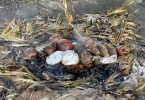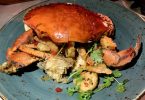After a dinner worthy of d’Artagnan, breakfast is a quick café au lait and croissants. I ask Madame at the hotel reception to direct us to the nearest service station. She draws us a map with directions, including how to get to the town of Auch and says, “faites bonne route.”
Bonne route is exactly what we are hoping for after circling Toulouse the night before and running low on petrol. Thankfully the car makes it there without requiring a push. With a full tank, we follow Madame‘s directions and get on the N124.

The scenery changes before our eyes with small family run farms occupying most of the land. The locals here are involved in breeding pigs and chicken, growing tobacco and corn, planting walnut trees to make oil, cultivating grape vines to make Armagnac and of course, breeding duck and geese.

This is foie-gras territory. The birds are force-fed on corn by a process called le gavage until their livers fatten. The foie-gras is then preserved in spring-lidded jars, or cans and can be enhanced by truffles and Armagnac. The birds are not suitable for roasting but the breast, known as the magret, is very lean and is usually served rare, either roasted or sautéed. The goose fat is usually used as a frying medium, the rind can be used to give flavour to stews while the limbs and gizzards are cooked slowly for hours to produce the confit which is later stored in earth pots, covered with fat.

I am beginning to water at the mouth as we pass many farm signs selling produits regionnaux. As much as we would like to stop, explore and taste, we have to reach the town of Condom by 11 am. We have an appointment for a visit at Janneau Fils SA, the oldest Armagnac house dating back to 1851.
We are running late. The D930 road is speed-limited. Too many trucks are slowing down traffic. Road works are in progress and Mr G who is usually calm and collected is getting frustrated by the minute.

The Armagnac region is close. Stretching around 50 km between Condom and Eauze, it has three principal areas : Tenazere in Condom, Bas-Armagnac in Eauze and Haut-Armagnac in Auch. Armagnac, which has a more earthy character than Cognac is made from St-Emilion Ugni-Blanc, Colombard and Folle Blanche grape varieties. The wine is only fermented for a few weeks and distilled in traditional alambic armagnacais which have replaced the alambic ambulante, the travelling alambics that visited various farms in the past.
The Armagnac still works by a constant process whereby the wine flows continuously from the vat to the still. The still is not stopped or cleaned. This way the new wine acts as a coolant for the vapours to condense, these in turn absorbing the flavour of the new wine while the older wine is heated to vapours. This method allows Armagnac to maintain the original character of the wine. The wine is then aged in casks made from the black oaks of the Monlezun forest.
Armagnac is also graded according to age. A three star Armagnac is aged for a minimum of one year in wood, VO, VSOP and Reserve for a minimum of four years while the Extra, Napoleon, XO and Vieille Reserve for a minimum of five. A friend from my university days introduced me to Armagnac long before I took to the enjoyment of alcohol. He would love to be here with us.
We finally break free from the trucks and approach the town of Condom long past our appointment time. The little town attracts visitors not for its amusing name but for the Gothic Cathedrale de Saint-Pierre rebuilt in the sixteenth century in original style, its medieval air and the Musee de l’Armagnac.
We pass the road sign announcing we are in Condom and become lost through its narrow streets. A map of the town provided little help as there is no arrow indicating vous etes ici and street signs are not a common sight in regional France. We are looking for number 50 avenue d’Aquitaine and find ourselves at the bottling and distilling plant of Janneau Fils, outside o the town where a worker found us in the cellar soaking up the aroma. He informs us that we are in the wrong place for a visite and that the premises would be closed for lunch as it is past midday.

The day is not proceeding as planned. We missed out on trying regional foie-gras products, the appointment at Janneau and doubt has set in. We’re uncertain if we are going to make it to the next appointments in the Médoc. Disappointed, angry and hungry, we stop in a small town outside of Condom for some Brie, a Pyrenees cheese and a washed rind cheese. At the boulangerie, the young man’s accent languedocien when he asks for “Trois-francs-cenquante” for a baguette makes me smile. There is no time to stop and eat. We fill the bread with cheese and devour it en route. A bottle of local wine would have appeased our mood but we settle on a cold Evian.
I fold the road map in half, and spot the regions of Quercy and Perigord, celebrated for their first rate tuber melanosporum or truffles. These rare culinary delicacies grow under ten to thirty year old oak trees, underneath a bare patch of soil with little or no vegetation, and can be found as deep as 25 centimetres between November and March. The art of truffle hunting requires special skills. Truffle hunters are usually accompanied by a highly trained dog or pig in detecting truffle aroma. Once the animal picks up the scent and begins digging into the ground, the hunter uses all his stamina to hold the animal back and distract it with a small morsel while he picks up the subterranean fungus. Truffles are used in a variety of dishes and have been mentioned in cookery back in ancient Roman times. We are yet to sample these delicacies, rightly referred to as culinary black diamonds.
Meanwhile, Alain Prost beside me attempts to get us on the D931 to Nerac then onto A6 to Bordeaux. Silence stretches between us. Car wheels hum on the road. I doze off for a little while, lulled by the rocking car and the hot sun aptly called soleil de plomb.
… continues tomorrow
‘Le Tour de France Gourmantic’ series is the story of a young couple from Australia who took to the French roads on a whirlwind Tour of France back when the internet wasn’t at everyone’s fingertips, phones were still attached to sockets, GPS was an unfamiliar acronym, digital cameras were a pipe dream and the Euro hadn’t replaced French Francs. With just one fold-out map of France and boundless enthusiasm, they took their Renault 19 and went on a cultural and culinary discovery.






[…] This post was mentioned on Twitter by Ms Gourmantic, Ms Gourmantic. Ms Gourmantic said: Condom, Armagnac, Foie Gras and Truffles http://bit.ly/dhgKx8 Le Tour de France Gourmantic continues #tdf #food #france #armagnac […]
[…] our visite to Janneau Armagnac in Condom gave us more impetus to reach our next destination on time. As we approach Bordeaux, I […]
[…] end, we take the road back to Bordeaux. It’s difficult to imagine that we have driven from Toulouse via Condom then all the way to one of the most prestigious wine region in France to visit Château Lafite […]
It’s okay to enjoy what the Gascogne has to offer you… but to eat foie gras of the “forced-fed” geese is really something we all should avoid!!!
I’ve heard of Eduardo Sousa in Spain, who feeds the geese natural. This is so much better!!! Read this article: http://www.thedailygreen.com/environmental-news/latest/free-range-foie-gras-50091809
Hi Martine – Ethical foie gras has been a popular topic of late, even on our distant shores. I haven’t had the chance to taste it yet or know of someone in my circle who has in order to do a comparison. I do however wonder if the movement will lead to a change of traditions in France, particularly if the end result is the same.
Love reading Gourmantic because even though I live here, I always learn about a new place I want to visit or thing I want to do! 🙂